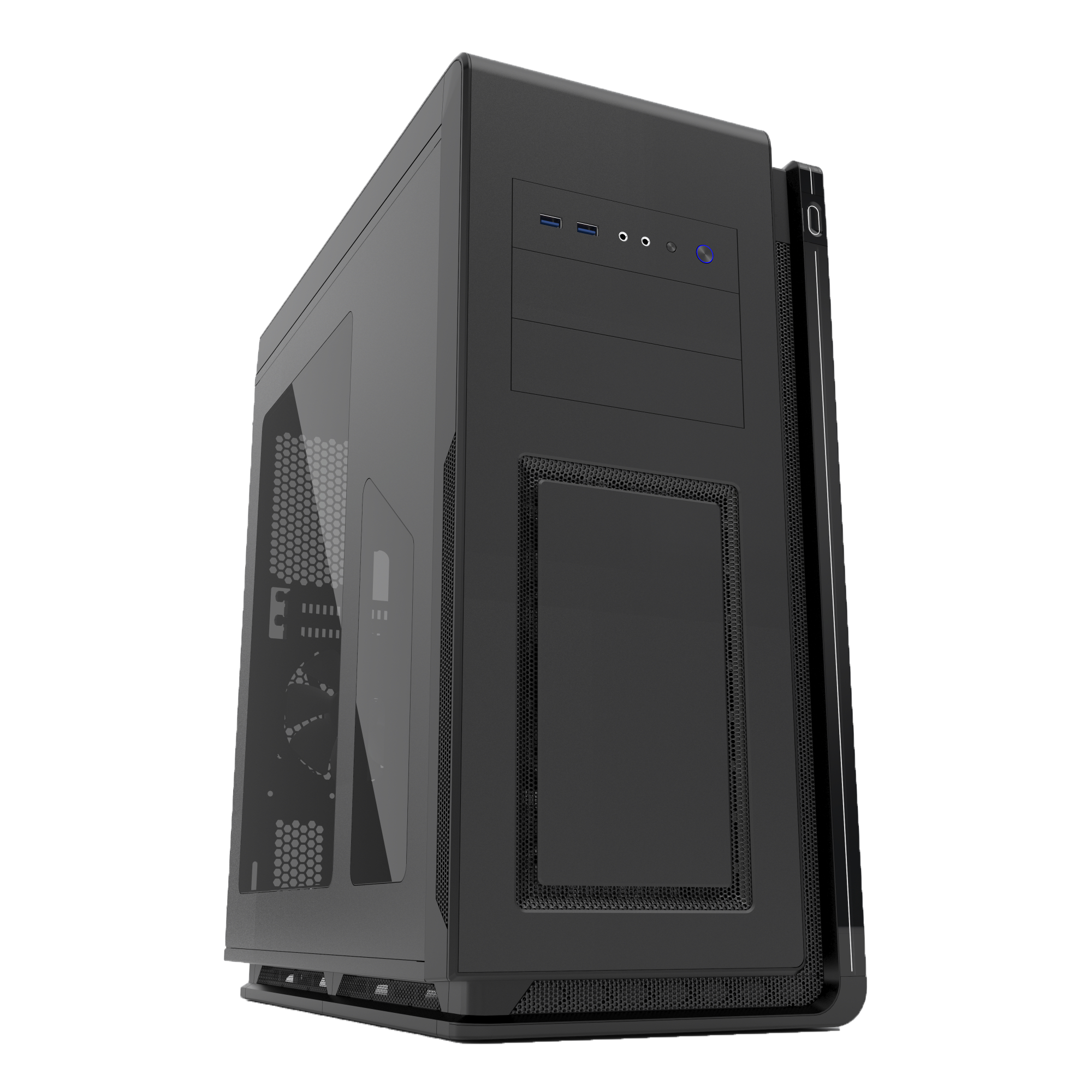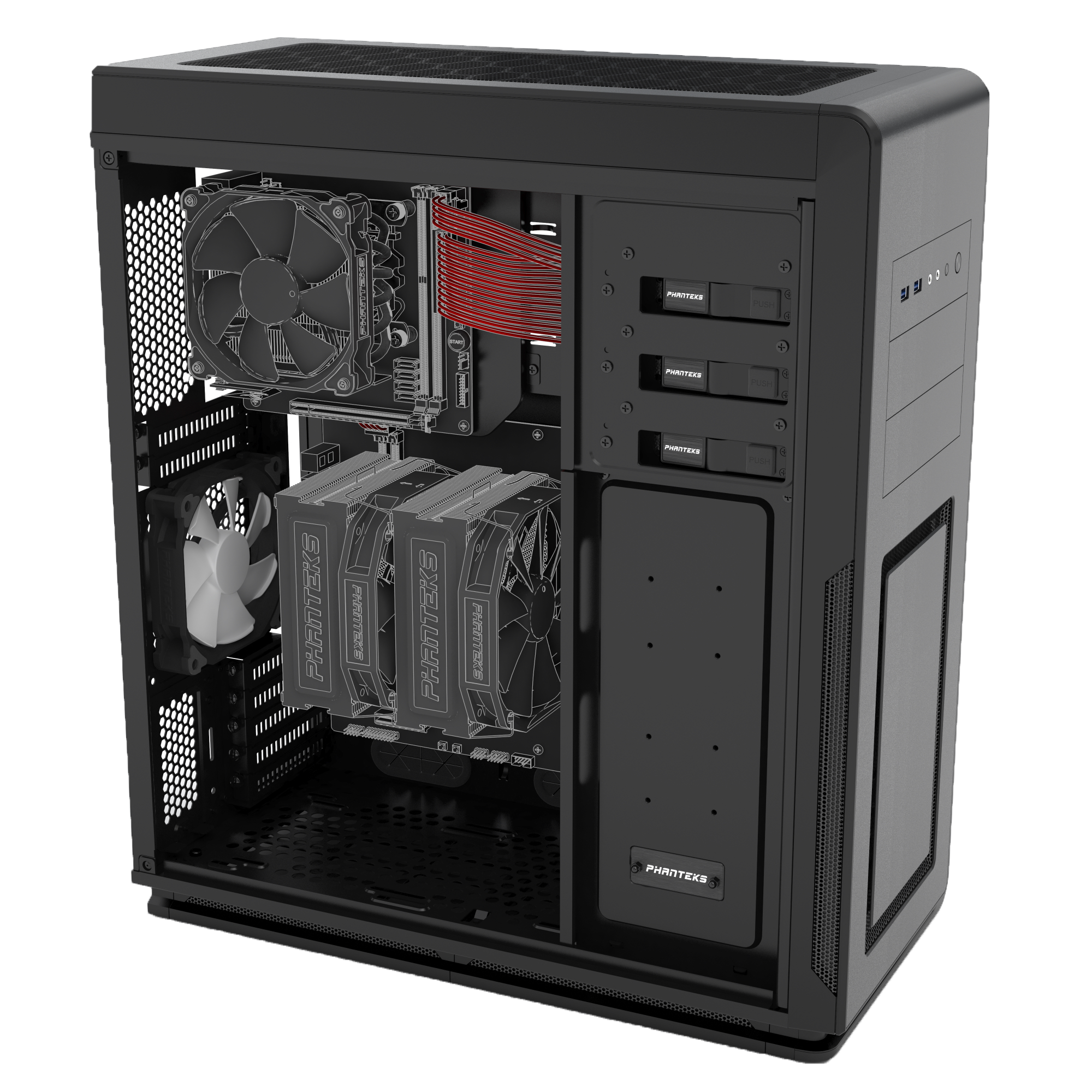One Chassis, Two PCs: Phanteks Releases Enthoo Mini XL With Dual System
Phanteks is back with a new version of its Enthoo Mini XL case. This time around, it’s called the Enthoo Mini XL Dual System, and as its name suggests, you will be able to put two systems in the case and one PSU to power both, thanks to the company’s power splitter component that we saw at Computex.
The case measures 550 x 260 x 480 mm (HxWxD) and has room for microATX and minITX builds. When you buy it, the package already comes with an ITX upgrade kit and the power splitter board. With two systems in one case, there are also two sets of I/O buttons: one located on top of the case and one in front.
For expansion and storage, it has five expansion slots and features two HDD cages, each with three slots for a total of six 3.5-inch HDDs. If you prefer SSDs, there are two SSD “Drop-N-Lock” slots. In addition to the two HDD cages, you could have a total eight SSDs for your system (that’s a lot of money). There’s also room for three 5.25-inch ODDs.
For graphics cards, you can have a GPU measuring up to 289 mm (410 mm if you don’t have the HDD cages in the way). Up to 215mm of clearance is allowed for the CPU cooler, and if you’re installing a radiator at the top, you’ll need 206 mm to get to the ATX motherboard.
You can cool the system with fans or liquid cooling, and Phanteks already added a few features to help out with either method. There is a seven-fan PWM control hub (upgradable to 11 fans with Phanteks’ Y-splitters), a pump bracket, two reservoir mount locations (a bracket or in the rear of the chassis), and a space to install a radiator on its side.
If you’re using 120mm fans, you can have a total of 13 for the system, with two in the front, three on top, one in the rear (already included), three in the bottom, two in the HDD cage area, and two on the side. You can also upgrade to 140mm fans, but then you’re limited to only six fans -- two in the front (already included), two at the top, and two on the bottom.
Liquid cooling allows for 120 mm and 140 mm radiators. On the 120 mm side, you can have up to a 240 mm (2 x 120mm) radiator on the front, top and side, and a 360 mm radiator on the bottom (3 x 120mm, no SLI). For 140 mm, you can have only a 140 mm radiator on the front and top, and a 280mm radiator (2 x 140mm) on the bottom.
Get Tom's Hardware's best news and in-depth reviews, straight to your inbox.
Phanteks didn’t have a specific release date, saying only that it’s coming out sometime this December. The new case will cost you $209.99.
______________________________________________________________________
Rexly Peñaflorida II is a Contributor at Tom’s Hardware. He writes news on tech and hardware, but mostly focuses on gaming news. As a Chicagoan, he believes that deep dish pizza is real pizza and ketchup should never be on hot dogs. Ever. Also, Portillo’s is amazing.
Follow Rexly Peñaflorida II @Heirdeux. Follow us on Facebook, Google+, RSS, Twitter and YouTube .
Rexly Peñaflorida is a freelance writer for Tom's Hardware covering topics such as computer hardware, video games, and general technology news.
-
cdabc123 why in any case would it be useful to have two small motherboards in a case? Any operation that's using the motherboards independently would be better accomplished by a single more powerful computer running a hyper-visor, or having 2 separate computers. If anyone out their can think of any reasonable use for this please inform me because im shocked a company would take the time to do this that may appeal to such a tiny group.Reply -
Gam3r01 Replywhy in any case would it be useful to have two small motherboards in a case? Any operation that's using the motherboards independently would be better accomplished by a single more powerful computer running a hyper-visor, or having 2 separate computers. If anyone out their can think of any reasonable use for this please inform me because im shocked a company would take the time to do this that may appeal to such a tiny group.
The only use I can think of (and it is listed on their website as well) would be a streaming system.
One system (the main board) runs the better hardware and provides the best gameplay possible, then the load of recording is handed off to the weaker system. This way you have a zero impact recording and streaming system. -
hammereditor The only useful purpose for this is if you are severely CPU-limited. Two quad-core Core i5's are much cheaper than one octa-core Haswell-E or Xeon E5.Reply -
dstarr3 Replywhy in any case would it be useful to have two small motherboards in a case? Any operation that's using the motherboards independently would be better accomplished by a single more powerful computer running a hyper-visor, or having 2 separate computers. If anyone out their can think of any reasonable use for this please inform me because im shocked a company would take the time to do this that may appeal to such a tiny group.
It'd be handy if you want to game with someone next to you and two PCs is the only way the game allows. Or if you are in content creation and need a rendering rig, but while you're rendering something, still need a general purpose computer to do other work.
It's definitely niche, but I can think of a good few uses for such a thing. -
JackNaylorPE Since it correctly states that this is an updated version, some info on how it differs from the one released over 18 months ago would have been beneficial.Reply
https://www.youtube.com/watch?v=r1nPVLuWFNo -
drtweak IF it was able to fit a full ATX board I might be into it. Why? My Media server is a Mini-ITX board. Embeded dual core celeron and 4 hard drives + SSD. Only uses 60 watts and is on 24/7 and a case for that takes up space. My main PC is a 8 Core AMD, GTX 480 and 1 SSD. That is it so someone like me might want to but that and save space.Reply -
JackNaylorPE It is ideal for situation where you want to combine server and workstation / gaming box usage. Server could be:Reply
Network file server on office or SOHO environment
Media Server
Game Server
-
firefoxx04 Why would anyone need more ram?Reply
Why would anyone need more than 2 cores? (when I was first getting into computers at age 14 thats all I read when i was considering the core 2 quad)
Why would anyone need that much wattage?
Why would anyone need more than a 240mm radiator?
Why would anyone overclock for such small gains?
Why would anyone need a case that big?
Whats the point of more resolution?
Why would anyone want more than one system in a case. I dont know, who cares. Sounds cool to me. -
alidan Replywhy in any case would it be useful to have two small motherboards in a case? Any operation that's using the motherboards independently would be better accomplished by a single more powerful computer running a hyper-visor, or having 2 separate computers. If anyone out their can think of any reasonable use for this please inform me because im shocked a company would take the time to do this that may appeal to such a tiny group.
The only use I can think of (and it is listed on their website as well) would be a streaming system.
One system (the main board) runs the better hardware and provides the best gameplay possible, then the load of recording is handed off to the weaker system. This way you have a zero impact recording and streaming system.
i can also see it being useful for 2 powerful computers, 1 powerful one you are using to do work, and a second one that you offload renders to, so your main computer has little to no impact and you can continue working.


